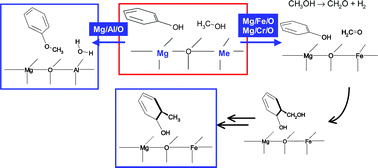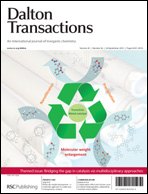This contribution reports about an in situ FT-IR investigation and the catalytic reactivity of Mg/Me3+ mixed oxides (Me = Cr, Fe, or Al; Mg/Me = 2, atomic ratio) in the gas-phase methylation of phenol with methanol. It is the second of two papers concerning the mentioned systems, and its purpose is twofold: to confute the classic and not accurate theory concerning the reaction mechanism, and to propose a novel interpretation based on the combined use of catalytic tests and in situ molecular spectroscopy. Results here reported highlight that: (i) the reaction mechanism in phenol methylation, when catalysed by basic systems, is not a classical electrophylic substitution, as generally reported in the literature, but proceeds through the formation of formaldehyde as an intermediate, and (ii) the catalytic behaviour in respect to both methanol and phenol reactants is strictly dependent on catalyst features. Although all investigated systems exhibit a basic-type behaviour with regard to phenol, which dissociates to yield an adsorbed phenolate species, the distribution of phenolic compounds obtained with the Mg/Al/O catalyst was that typically observed with acid catalysts, with prevailing formation of anisole when the reaction was carried out below 350 °C and of mono and poly-C-alkylated compounds when the reaction temperature was above 350 °C. On the contrary, the reactivity shown by both Mg/Fe/O and Mg/Cr/O systems was that reported in the literature as typical of mixed oxides possessing basic features. The extent of methanol decomposition into light compounds was maximum in the case of Mg/Fe/O catalysts, because of the pronounced redox behaviour typical of Fe3+ species, whereas neither methanol dehydrogenation nor decomposition were ever observed with Mg/Al/O up to 400 °C. Reactivity tests and spectroscopic experiments hinted for methanol dehydrogenation to formaldehyde as the first step in the ring-methylation of phenol with Mg/Cr/O and Mg/Fe/O: in that case, o-cresol and 2,6-xylenol were the only reaction products. But, with Mg/Al/O systems, for which no methanol dehydrogenation occurred, the formation of anisole was due to the synergistic effect of stronger basic features and the presence of Lewis acidic sites, that facilitate the reaction between phenol and methanol after activation over the two different types of catalytic sites.


 Please wait while we load your content...
Please wait while we load your content...